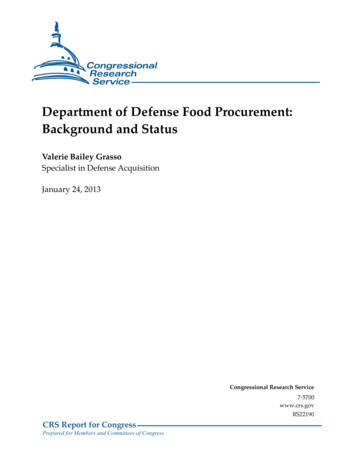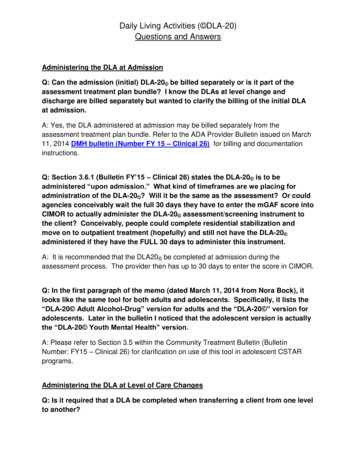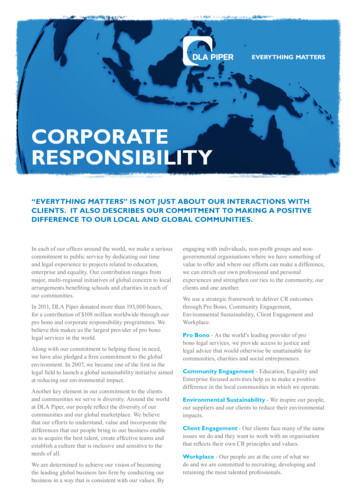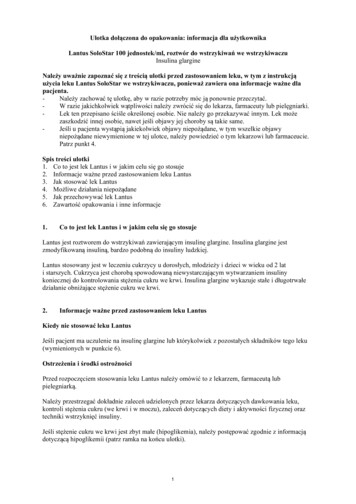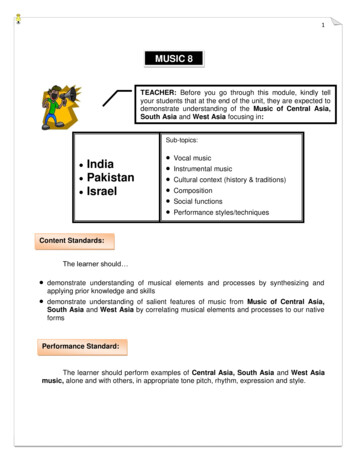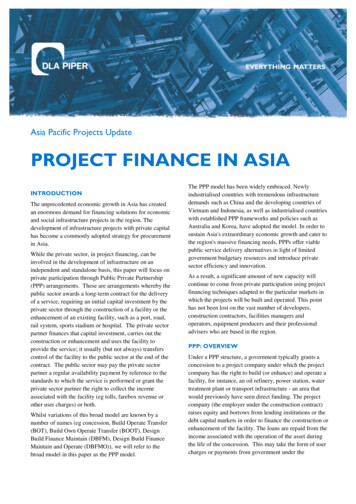
Transcription
Asia Pacific Projects UpdatePROJECT FINANCE IN ASIAINTRODUCTIONThe unprecedented economic growth in Asia has createdan enormous demand for financing solutions for economicand social infrastructure projects in the region. Thedevelopment of infrastructure projects with private capitalhas become a commonly adopted strategy for procurementin Asia.While the private sector, in project financing, can beinvolved in the development of infrastructure on anindependent and standalone basis, this paper will focus onprivate participation through Public Private Partnership(PPP) arrangements. These are arrangements whereby thepublic sector awards a long-term contract for the deliveryof a service, requiring an initial capital investment by theprivate sector through the construction of a facility or theenhancement of an existing facility, such as a port, road,rail system, sports stadium or hospital. The private sectorpartner finances that capital investment, carries out theconstruction or enhancement and uses the facility toprovide the service; it usually (but not always) transferscontrol of the facility to the public sector at the end of thecontract. The public sector may pay the private sectorpartner a regular availability payment by reference to thestandards to which the service is performed or grant theprivate sector partner the right to collect the incomeassociated with the facility (eg tolls, farebox revenue orother user charges) or both.Whilst variations of this broad model are known by anumber of names (eg concession, Build Operate Transfer(BOT), Build Own Operate Transfer (BOOT), DesignBuild Finance Maintain (DBFM), Design Build FinanceMaintain and Operate (DBFMO)), we will refer to thebroad model in this paper as the PPP model.The PPP model has been widely embraced. Newlyindustrialised countries with tremendous infrastructuredemands such as China and the developing countries ofVietnam and Indonesia, as well as industrialised countrieswith established PPP frameworks and policies such asAustralia and Korea, have adopted the model. In order tosustain Asia's extraordinary economic growth and cater tothe region's massive financing needs, PPPs offer viablepublic service delivery alternatives in light of limitedgovernment budgetary resources and introduce privatesector efficiency and innovation.As a result, a significant amount of new capacity willcontinue to come from private participation using projectfinancing techniques adapted to the particular markets inwhich the projects will be built and operated. This pointhas not been lost on the vast number of developers,construction contractors, facilities managers andoperators, equipment producers and their professionaladvisers who are based in the region.PPP: OVERVIEWUnder a PPP structure, a government typically grants aconcession to a project company under which the projectcompany has the right to build (or enhance) and operate afacility, for instance, an oil refinery, power station, watertreatment plant or transport infrastructure - an area thatwould previously have seen direct funding. The projectcompany (the employer under the construction contract)raises equity and borrows from lending institutions or thedebt capital markets in order to finance the construction orenhancement of the facility. The loans are repaid from theincome associated with the operation of the asset duringthe life of the concession. This may take the form of usercharges or payments from government under the
concession or offtake agreement (or a combination ofboth). At the end of the concession period the facility isusually transferred back to the government, hopefullyafter the project company has obtained a return for itsequity investors. This type of structure is popular withgovernments in the region as it enables them to developinfrastructure projects without committing their limitedresources upfront to particular projects.Strictly speaking, a PPP structure is, in itself, a structurethat involves non-recourse or limited recourse financing.That is, financing where lenders are repaid solely from thecash flow generated by the project and whose onlysecurity is in that revenue and the assets of the project.However, pure non-recourse or limited recourse financingcan be difficult to obtain in this region as lenders areseldom willing to commit the large amounts needed fortoday's international projects solely on the basis of aproject's expected cash flow or assets.Accordingly, most international project financings(especially in the emerging markets of Asia) tend to befinanced on a basis that minimises the lender's risks byincorporating a number of back-up or secondary means ofcredit support provided by the host government, sponsors,purchasers or other counterparties, while also relyingprimarily on the project company's cash flow to servicethe debt and security provided over the assets of theproject company. However, credit support by sponsorscan effectively operate to defeat the limited recoursenature of the project financing (see credit agreements andsponsor participation in the sections below). For thatreason, it is important to pay special attention to theallocation of risk when using sponsor support to create abankable project.THE CONTRACTUAL FRAMEWORKA PPP is a relatively complex structure with a large number of elements that need to be combined and integrated. It requiresan extensive network of inter-related and often inter-conditional contracts, as outlined in the simplified structure shown inDiagram 1.Diagram 1: Typical PPP project structure: principal parties and various contractsA PPP will usually include all or at least a majority of thefollowing agreements.Concession agreementA concession agreement, licence or mineral lease betweenthe government authority and the project company is thecornerstone of the structure as it effectively gives theproject company the right to carry out the project.Concession agreements and the extent to which theyaddress specific sponsor protections will vary significantlyin Asia. Very few countries in Asia have laws specificallydealing with PPP projects as a group. In some cases, the2 PROJECT FINANCE IN ASIAright to carry out the project is sourced in speciallegislation enacted by the relevant government. Forexample, in Hong Kong, infrastructural facilities such asthe Cross-Harbour Tunnel, Western Harbour Crossing andTate's Cairn Tunnel are governed by individually enactedordinances, where each particular project scheme mustfirst be approved by the legislative council.In other countries the concession agreement will be a veryloosely drafted document where parties will rely more onthe goodwill of the host government (and its need todevelop projects in the future) than on the contractual
terms of the concession agreement. As a consequence,sponsors and lenders are often faced with concessiondocumentation that is not as comprehensive as they mightlike.The position taken by sponsors and/or lenders in thissituation varies. Nevertheless, even where the sponsorsand/or lenders are of the view that a concession agreementrequires amendment, they should bear in mind that thereare often sensitive political matters that need to beconsidered when requesting changes. Hence, it is notunusual for lenders and/or project sponsors in this regionto find themselves in a position where they mustdetermine whether what they perceive as a deficiency inthe concession agreement is, or can be, dealt with in a wayother than through amendment of the document. Forexample, should the deficiency simply be considered asanother manifestation of any political risk associated withthe project?Many countries are aware of the considerable drawbacksthat arise from such practice and legislative initiativeshave been introduced to address these inadequacies. Forexample, China, a country that traditionally regulatesprojects on a case-by-case basis though contracts, hasenacted legislation regulating infrastructure concessionssuch as The Urban Infrastructure Concession Regulationof Beijing Municipality, 1 March 2006.Offtake agreementRevenue risk can be managed through an offtakeagreement between the government authority and theproject company by providing the project company with asufficient pre-determined revenue stream to ensurepayment of its project obligations, operating costs and areturn for its sponsors. An offtake agreement willtypically take the form of a "take-or-pay" agreement,which provides that the offtaker has the option of eithertaking the project's product or paying for the product(even if it is not taken) at the agreed tariff. Long-termagreements such as these would normally be entered intofor gas or electricity generation projects, since sales wouldnot be made on a spot or retail market.Although the structure of these agreements does notgenerally cause a problem under English law, with theexception of poorly drafted take-or-pay provisions thatmay constitute a penalty, this is not always the case incountries in this region. In a number of jurisdictions in theregion, particularly those which do not have an Englishlaw background, the adequacy of consideration in acontract is of great importance. For example, while anEnglish court will generally not be interested if a utilityends up paying 10 times the market price for gas becauseof its take-or-pay obligations, this can be of greatimportance elsewhere. Therefore, proper advice should be3 PROJECT FINANCE IN ASIAtaken regarding proposed offtake agreements, not only inrelation to their enforceability but also in relation to theirstructure. Another consideration that may arise in some ofthe more regulated economies in the region is whether anadequate offtake agreement can be negotiated. Forexample, if electricity prices are subject to centralcontrols, it may not be possible to simply "pass through"costs to the offtaker (as is the case in China).Construction contractA construction contract between the project company andthe construction company will typically be in the form ofa comprehensive turnkey contract, which should ensurethat the contractor will deliver a completed andoperational facility. The turnkey model provides for theproject, capable of meeting its projected operatingstandards and contractual obligations, to be handed overand be ready for immediate operation. For that reason, it isnot unusual for sponsors to try and shift all completionrelated risks onto the contractor.Nevertheless, participants in projects in this region shouldbe prepared to consider variants to familiar contractualstructures. For example, it is possible in Thailand andIndonesia for a project company to avail itself of certaintax savings if the construction contracts are structured sothat there is a clear division between work that is carriedout onshore and that which is carried out offshore.Furthermore, licensing restrictions in Vietnam may alsonecessitate splitting the turnkey contract. Accordingly,some participants in such a project will need to review anypreconceptions they might have as to how the constructiondocumentation should be structured.Supply agreementsA fuel supply agreement between the project companyand the fuel supplier varies in sensitivity depending on thefuel used by a project and the source and ownership of thefuel. Security of supply and price certainty is of keyimportance for the project. It is also important that fuelpricing and adjustments of terms are capable of beingpassed through under the offtake agreement in order toprotect the project’s revenue projections and debtservicing capacity. The development of complex andinnovative fuel supply and storage strategies may beneeded if long-term fuel supply agreements are notavailable. This would not be necessary where the projectprovides its own raw materials or the project itself is theactual extraction of natural resources.There may also be an equipment supply agreement(s) witha supplier(s).Operating and maintenance agreementAn operating and maintenance agreement between theproject company and the operator allocates facility
operational risks and aims to ensure that the operatormeets performance guarantees tied to maximisingrevenues under the project’s offtake agreement orachieving minimum standards under the concessionagreement. Special attention should be paid to managingthe costs of operating the facility, interface and handovertransition from the construction contractor, scheduled andunscheduled maintenance and ensuring that the projectrevenues are protected by establishing appropriate costcover and/or pass-through mechanisms in the offtakeagreement.project). Sponsor support is also addressed in relation tosponsor participation (see discussion below).Shareholders' agreementIf, however, the project company is able to operate andmaintain the facility itself, then an operating andmaintenance agreement would not be necessary.A shareholders' agreement sets out the respective rightsand obligations of the sponsors with respect to each otherand the project company. In project financing, specialattention should be paid to the handling of potentialconflicts of interests. This is especially the case whereboth private sector sponsors and the host government areequity holders. Depending on the jurisdiction, theapplicable laws surrounding the negotiation and draftingof shareholder agreement provisions may require certainissues to be resolved in other documents, such as theproject company’s constitutional documents.Credit agreementDirect agreementA credit agreement is the principal legal documentbetween the banks and the project company that detailsthe express terms on which the banks will advance fundsto the project company together with any associatedsecurity documents. Some of the issues parties will needto consider are: the currency of the loans (should they bedenominated in the principal currency of expenditure orthe currency of the projected revenues?); themanageability of the drawdown and reportingrequirements from the project company's point of view;and whether any control amount requirements reflect locallegal requirements. For example, any instance of a rigidonshore account/offshore account structure will not beappropriate if exchange control consent is required foreach transfer of foreign currency offshore.Direct agreements are typically between the banks andkey contract counterparties, such as the constructioncompany, operator and offtaker, and are required toprotect the economic interests of the banks. Circumstancesmay arise where the project company is unable to meet itsliabilities and the banks will seek to enforce their securityinterests and therefore look to direct agreements to givethem the ability to keep the key contracts on foot, despitethe insolvency of the project. Direct agreements havebecome customary practice in project finance since nonrecourse financing limits the security of the banks to thecore assets of the project company, such as projectfixtures, property and the revenues of the projectcompany. The granting of security over the projectcompany’s assets for its borrowings can be quite complexif third parties become involved in the securityarrangements. The involvement of third parties may benecessary if security is being created over contractualrights, which is typically the case.In certain cases, for example where an engineering,procurement and construction contract wrap cannot beobtained, it may be necessary to provide sponsor supportto strengthen the capacity of the project company tosatisfy its obligations to the banks and to have a"bankable" project. Forms of sponsor support may includeequity subscription agreements (base and standby equity),completion guarantees of whole or part of the debt untilthe project commences commercial operation, bankguarantees to support completion guarantee, and costoverrun guarantees/facility. Sponsor guarantees can bemade to cover the bank debt or completion guarantees for example, by ensuring that the lenders will be paid backa set amount if the facility does not reach completion orthe repayment of scheduled debt service, of principal plusinterest, if completion is delayed. Other forms of supportmay be incorporated where the sponsor is a party to a keyproject contract (such as a construction contract, operatingand maintenance agreement, or offtake agreement byrequiring the sponsor to provide additional guaranteeletters of credit or corporate support to underpin the4 PROJECT FINANCE IN ASIADirect agreements should not improve or worsen thesituation for any of the parties and project contractsshould be structured so that the interests of the lenders canbe protected without adversely affecting the ability of theproject company and the counterparties in exercising theirrespective rights and obligations under the variouscontracts. Step-in rights, whether structured on apermanent or temporary basis, are a key benefit to a directagreement. This is because, if the project finds itself introuble, it allows for banks to place themselves ("step in")to the position of the project company under the contractsover which they have security on pre-determined terms.Certain jurisdictions may not allow direct agreements tobe entered into and step-in rights may need to bestructured in a different form.It is of vital importance that these agreements are properlystructured to ensure the bankability of the project.
RISK IDENTIFICATIONRISK ALLOCATIONThere are a variety of potential project risks, some moreeasily identifiable than others. It cannot be expected thatall risks will be mitigated or contracted away. However,proper identification, assessment, allocation andmanagement of risk can create a commercially viable andbankable project, and play an important role in assessingthe need for back-up of secondary credit support(discussed above). PPPs are generally structured on abasis that requires all parties to share the risks of theproject. Project risk-sharing is necessary because theproject company will usually have limited equity, which issubstantially less than the aggregate net worth of thesponsors.At its most basic allocation, risk in a PPP will beapportioned as follows: market risk will be borne by thesponsors; detailed design, construction andcommissioning risk will, to a large extent, be taken by theconstruction company; operating risk will be taken by theoperator; and all residual risks, including those risksarising as a result of the mismatching of risks amongparticipants (including insurers) will be taken by theproject company. Many of the project risks identified inthe previous section are allocated to stakeholders in theproject through the project documents such as thosediscussed above in "The Contractual Framework".However, the government and the lenders may also bear asignificant proportion of these risks, albeit indirectly. Forexample, if the project company is responsible forproviding fuel and the fuel is below the specified quality,a power station might not be able to perform to therequired specification. To alleviate this problem, theproject company must back-to-back its obligations to theconstruction company under the construction contractwith its entitlements under the offtake agreement with thegovernment. The risk would, therefore, ultimately end upin the hands of the government and/or the lenders, whichis not a position they set out to achieve.Factors such as the type and scale of a project, the countrywhere the project is located and the type of PPPimplemented create a unique set of risks for each project.Risk identification is the first step to managing themappropriately and parties generally identify project-levelrisks by breaking them down in three ation.Within each of these stages multiple sources of risk exist.Table 1 categorises each stage and outlines general nonproject/region specific sources of risk to consider.Table 1: List of Potential Risks: Non-Project/RegionSpecificThe highest degree of risk exists during the constructionphase of a project, as funds have been advanced and therevenue stream on which the lenders and investors arerelying upon for repayment has not yet commenced.Once the project's risks are identified, the likelihood oftheir occurrence assessed and their impact on the projectdetermined, the risks and obligations should then beallocated to the parties with the best financial andtechnical capabilities to manage them, thereby spreadingthe risk and responsibilities to create a bankable project.Therefore, the primary consideration at the outset inanalysing risk sharing is that the risk must be placed witha party to the PPP structure, which is willing and able toaccept and manage that risk.5 PROJECT FINANCE IN ASIAThe allocation of risks in this way helps to mitigate therisk where possible, by either reducing the likelihood ofrisk occurrence or the impact of the consequence, if therisk were to occur. Transferring the risks to the party whois in a better position to manage and control the risk at alower premium or cost is a beneficial mitigationtechnique. The selection of experienced, qualified andfinancially strong parties with proven track records indeveloping similar projects can enhance protection againstperformance risks. Other mitigation tools includeinsurance for events such as force majeure or businessinterruption and the employment of hedging instrumentsto mitigate macroeconomic risks such as interest rate,inflation and foreign exchange risk.The participating parties may include:Government/government authorityInfrastructure projects in this region will normally involvethe local government, either acting through its ministriesor an appropriate government authority. It is normally thepivotal player. It will initiate the project, conduct thetendering process and evaluation of tenders and will grantthe project company the concession. The localgovernment also either grants a long term lease of, or sellsthe site for, the project to the project company and willoften acquire most or all of the service provided by thefacility. Typically, the government will try to limit itsliability and seek to retain a level of control over the
project, while limiting its undertakings and retainingflexibility.A critical issue to consider here is whether thegovernment authority has the appropriate statutory powerto enter into each of the project documents to which it is aparty and perform its obligations thereunder. If theauthority does not have the requisite powers, its actionswill be ultra vires, and therefore void. To determinewhether a government authority's actions are intra vires orultra vires, it is necessary to examine the legislation underwhich the authority is constituted. If the legislation doesnot give the authority the power to enter into and carry outthe project, the legislation will need to be amended by thegovernment so that the project can be carried out.Furthermore, many of the projects proposed in this region,for example in China, involve government authoritiescommitting assets, such as land, to the project company asopposed to subscribing for shares. Care must be taken,especially in controlled economies, to ensure that theauthority involved actually has title to the assets beingtransferred to the project company. If not, the appropriategovernment agencies will have to be approached.Also, in the case of PPPs, government utilities and entitiesare often the offtakers of the project's product (such aspower). As such, under the terms of the offtakeagreements governing such purchasing, a governmententity may guarantee payment in respect of certain levelsof product output. For example, in countries such asKorea, risk sharing strategies have been adopted for PPP,such as the Minimum Revenue Guarantee (MRGScheme), as a way for the government to guaranteepayment to private investors if revenues fell below acertain level or performance. However, the MRG Schemewas abolished in 2009 due to criticism over unreasonablyhigh returns to private investors and its being morallycounterproductive with regard to incentivising privateoperators to generate revenues. It has since been replacedwith a similar risk sharing strategy.Project companyThe project company will usually be a company,partnership, limited partnership, joint venture, or acombination of these. This will be influenced by the legaland regulatory framework of the host government. Forexample, foreign participation in large-scale projects inChina is usually through a joint venture arrangement withthe government or the state-owned enterprise responsiblefor the development of the particular industry. The taxregimes and foreign exchange rules may also affect theownership structure.As mentioned previously, many PPP projects arestructured deliberately to insulate the project companyfrom as many risks as possible and ring fence the liability6 PROJECT FINANCE IN ASIAof the sponsors. In these cases, the project company isintended to be a mere financing vehicle and risks will bepassed through it.Sponsors and shareholdersThe project sponsors are those companies, agencies orindividuals who promote the project and bring togetherthe various parties and consents necessary to get it underway. They are usually involved in some aspect of thework, for example the construction, operation, purchase ofservices or ownership of the land. They are invariablyinvestors in the equity of the project company and may bedebt providers or guarantors of aspects of the projectcompany's performance. Since infrastructure projectstypically consist of risks that are beyond what projectsponsors may be willing or are able to provide or assumethemselves, project financing can be appealing to sponsorsfor several reasons. In addition to providing for theallocation of project risks among multiple participants, aproject finance structure takes the form of financing that islegally non-recourse to the sponsor, it can achieve "offbalance sheet" accounting treatment of project debt, and itallows for highly leveraged structures.The support provided by project sponsors varies fromproject to project and includes the giving of comfortletters (which is not particularly common in projects inthis region), cash injection undertakings (both pre- andpost-completion), as well as the provision of completionsupport through letters of credit. For example, completionor cost overrun guarantees may be a requirement of thelender as a condition to providing debt (see creditagreements discussed above "The ContractualFramework").Private sector lenders and banksFactors such as the political, economic and socialimportance of the project development, the location andthe commercial risks will have an impact on the types ofproject lenders. In addition to the possibility of publicsector lenders such as multilateral and Export CreditAgency (ECA) involvement, which will be discussedbelow, due to the sheer scale of the project the financingfor a PPP will usually involve a syndicate of banks and,from within that syndicate, an arranging bank or banks,which will take the lead role in negotiating the project andfinance documents. It must be kept in mind that lendersmay face the full risk of loss if the project fails as theyhave no recourse (on a non-recourse project financingbasis) other than to the assets of the project. Their appetitefor risk should be adjusted accordingly. The syndicate willmost likely include banks from the host country,particularly if there are restrictions on foreign bankstaking security over project assets. Involvement of localbanks can offer risk mitigation by providing local
knowledge of the regulatory system and politicalenvironment and local currency financing to provide anatural hedge to currency exposure in the project.The syndicate will necessarily undertake a review of allcore project documents to assess the allocation of risksand how that allocation impacts upon their credit approvaland the need for additional credit support. These will oftenbe evaluated in conjunction with an experiencedengineering firm, which will assess the design of theproject and the technical aspects of the contracts. It isimperative that the promoters of the project and theirconsultants and advisors understand that this review of thedocumentation is an essential part of the credit process fornearly all lending institutions and that the comments andrequirements of the lending institutions will not be dealtwith by insisting that the documentation reflects theagreement reached by the various non-lending parties and,therefore, cannot be changed. It is also important that thepromoters of the project and their consultants and advisorsappreciate that the requirements of the lenders and theirappetite for risk is different from sponsors of projectsfunded "on balance sheet", where those sponsors have asuccessful track record of delivering similar projects andare willing to put their balance sheet at risk for a return onequity. In fact, the most prudent approach would seem tobe that the project implementation structure, contractualframework and contract documentation should bedeveloped in consultation with the lending institutions, ifat all possible, particularly as issues such as theirassignability, payment mechanisms and the underlyingrights of termination will be of importance to the lenders.One of the principal concerns the lenders will have, apartfrom satisfying themselves as to the generalapportionment of risk, will be to ensure that they can takeeffective security over all or the principal assets of theproject.Public sector lenders: multilaterals and ECAsMultilaterals and ECAs are, fundamentally, governmentbacked suppliers of financing and other credit support thatpossess a variety of tools that are typically unavailable tocommercial entities on their own. Such institutions arefounded on the basis of policy established at an intergovernmental level rather than commerce. The use ofthese organis
development of infrastructure projects with private capital has become a commonly adopted strategy for procurement in Asia. While the private sector, in project financing, can be involved in the development of infrastructure on an independent and standalone basis, this paper will focus on private participation through Public Private Partnership
